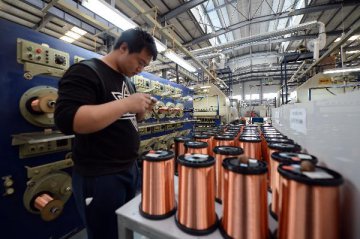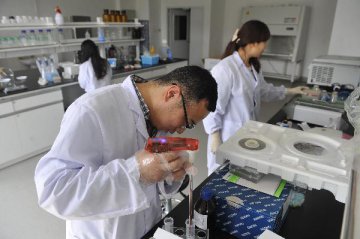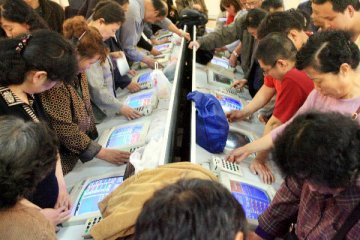
According to statistics from the National Bureau of Statistics (NBS), China’s emerging industries achieved rapid growth in the first quarter, bringing warm spring to the Chinese economy which is facing downside pressure.
Data: emerging industries show signs of rising
The economic data of the first quarter shows that industrial development continues to point to medium and high end. Value added of the high-tech industry and equipment manufacturing industry in the first quarter increased by 9.2 percent and 7.5 percent respectively, 3.4 percentage points and 1.7 percentage points higher than that of industries above designated scale respectively, and accounting for 12.1 percent and 32.4 percent of value added of industries above designated scale respectively, up 1.1 percentage points and 1.7 percentage points from the same period last year.
In fact, rapid rising of emerging industries propels economic transformation and growth. Such signs are becoming increasingly clear and are reflected in various aspects.
Sheng Laiyun, spokesperson of the NBS, indicated that the structure of demand, especially the investment and consumption structure, continues to optimize in the first quarter. The growth of investment in the high-tech industry and service industry maintained about 3 percentage points higher than that of overall investment, with the proportion continues to increase, while the proportion of investment in high energy consumption industries continue to drop. Significantly, the highlights of the economy in the first quarter is rapid development of new economies, expedited concentration of new impetuses and good momentum of innovation and entrepreneurship. Increases of 10 percent and 9.2 percent for emerging industries and high-tech industries all mean that the pattern of development is changing, and green development is progressing.
The journalist learnt at the 119th China Import and Export Fair that impacted by complicated and severe situations at home and abroad, increasing downward pressure on the economy and uncertainties, operation rate and order rate of many traditional manufacturing industries have been falling since the end of 2014. Enterprises face difficulties in operation, and their vision for future development also blurred.
In comparison with manufacturing enterprises in difficulties, enterprises in strategic emerging industry are relatively relaxed. Take several photovoltaic (PV) manufacturing enterprises for example, small and medium-sized PV enterprises estimated that the orders they are able to complete during the year will increase by more than 20 percent; some larger PV enterprises expand even faster.
Challenge: pain of structural adjustment will last
Experts in the industry pointed out that the low level of micro indicators of industries with high energy consumption and overcapacity is intuitively a demonstration of economic slowdown. But in fact, it is what the macroeconomic policy has pursued in recent years.
“Under the market mechanism and guidance from the government, positive and obvious changes have taken place in our economic structure in recent years. In particular, traditional industries have grown at rather low speed and some even experienced negative growth; the growth rates of strategic emerging industries are generally one time higher than that of GDP. But in reality, we feel quite the opposite: pains are greater than surprise,” Huang Zhiling, chief economist with the Construction Bank of China, told the journalist.
In Huang’s opinion, it could be attributed to various reasons. As high energy consumption and high-polluting industries, mining industry, overcapacity industry, and low-end manufacturing industry are industries with huge scale, though continuously slow growth and shrinking of these industries in structural adjustment conform to the expectation of the market and policy, it also has tremendous adverse impact on GDP; the high-tech industry, high-end equipment manufacturing industry, strategic emerging industries and some service industries, though in positive trend in general, their scale are far smaller than the aforesaid industries. And the contribution from the latter cannot fully offset adverse impact from the former. As a result, GDP has been facing huge downside pressure.
Huang pointed out that in structural adjustment focusing on industrial upgrading, tons of outdated production capacity needs to be obliterated, while advanced manufacturing industry and strategic emerging industries that hope for rapid development are still at primitive stage, confronting high technical threshold to form industrial scale. For subdivided industrial sectors whose growth is apparently higher than that of GDP, their volume is just 14 percent of the total industrial output. However, the volume of industries growing at 5 percent or lower accounted for 64 percent of the total industrial output. In other words, the incremental of rising industries cannot make up reduction of depressed and declining industries.
In addition, the advanced manufacturing industry and high-tech industry are featured with the substitution effect of technologies as well as the high threshold for practitioners. The pressure on the total employment and employment structure will see meager alleviation even if the development scale of these industries fills up the market share lost by obsoleting low-end and extensive industries. New jobs provided by the hi-tech industry can hardly offset the pressure posed by employment reduction of traditional industries.
Teng Tai, head of Winbro Economic Research Institute, told the journalist that seen from the economic operation status in the first quarter, both the supply-side and the demand-side have seen structural changes under the joint push of governmental support and market force, further enhancing the driving force of service sector and consumption.
But Teng also pointed out that on the one hand, new supply and new momentum keep emerging; and on the other hand, supply contracts faster than demand, so the economy is dipping to the bottom after five-years of downtrend.
Countermeasure: policies frequently released to boost economic transformation
“Pains brought by economic structural adjustment are unavoidable and it is the same for any countries and economies. But macro policies can still make their contribution to relieve the pains and guarantee smooth transformation of economic growth pattern”, said Huang.
Huang stressed that current stock labor supply hardly meets the demand of new economic structure during industrial upgrading-oriented economic structural adjustment. Current labor faces pressurized and tough re-employment. Training and guidance for the re-employment of current labor remain to be a tough nut to crack for the government.
Teng also pointed out that any economic structure transformations are always accompanied with pains. The most important thing is how to cultivate new supply, momentum and employment opportunities to ease the pains. The government should foster advanced factor market, and help to transfer management factors including land, capital, labor and technologies from industries with excess supply to industries seeing new supplies or supply expansion. The shutdown of enterprises seeing excess supply does not mean completion of structural adjustment, but the transfer of factors into new industries seeing new supplies or supply expansion does.
In fact, emerging industries have always been prioritized by decision-makers as the main force of future manufacturing industry and are deemed to be able to effectively improve China’s industrial structure. Hence, the government keeps intensifying efforts. It is proposed in the 13th five-year plan that China will implement 100 significant projects in next five years, over half of which are associated with emerging industries.
The journalist learns from several authoritative departments that specific implementation plans for a slew of significant projects in relevant industries will be released this year. The 13th five-year plans for emerging industries, including new material, next generation information technology and rail transit, will be formulated and released within 2016. The Ministry of Industry and Information Technology (MIIT) will also roll out guidance on promoting “Made in China 2025” strategy and the integrated development of “Internet Plus”, a move to combine the manufacturing industry, “Internet plus” and “massive innovation and entrepreneurship”.
Translated by Adam Zhang & Jennifer Lu






















Latest comments